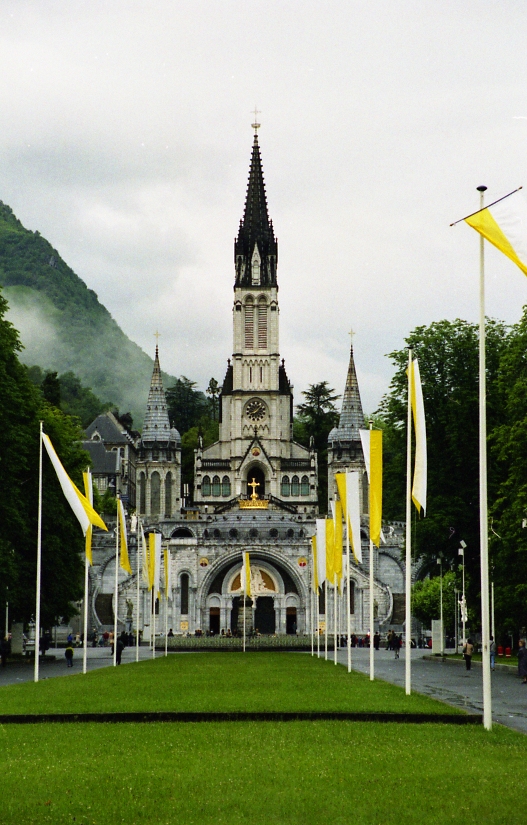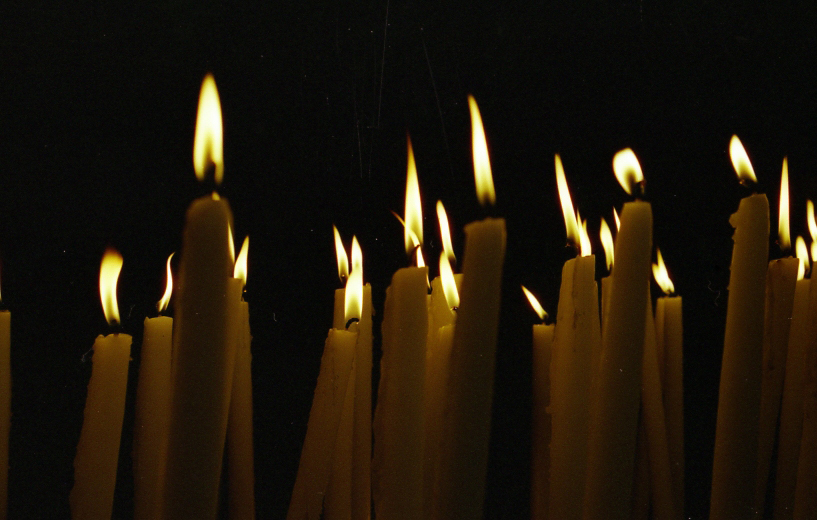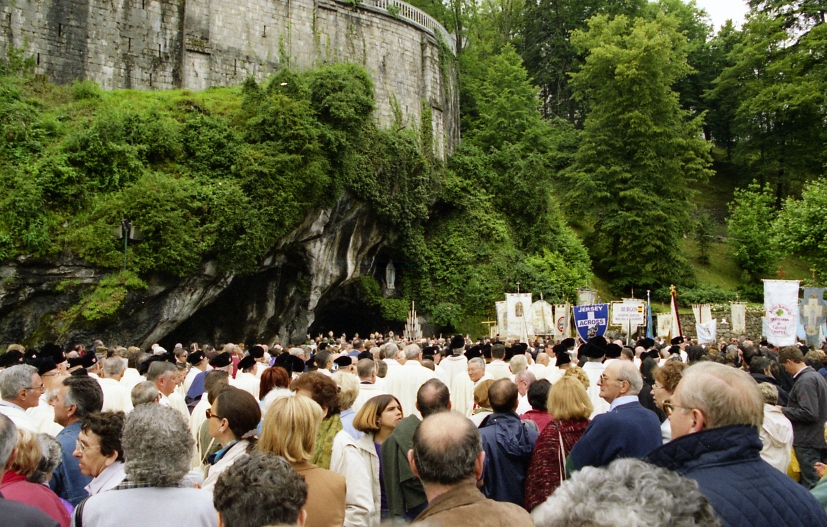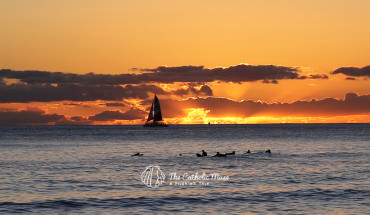(previously published in The Catholic Voice)
Five years ago, my family and I went on a pilgrimage through the south of France to the Grotto of Lourdes where Mary spoke the words — “I am the Immaculate Conception” — words the young Bernadette needed to carry out God’s plan of calling his people to expectant faith.
As our bus crawled down the narrow cobblestone road, my expectant faith started to wane. The street was lined with merchants hocking cheap rosaries and plastic statues for pilgrims to fill with water. Off in the distance was the cathedral, which looks a lot like Cinderella’s castle. “It’s the religious person’s answer to Disneyland,” my mind complained quietly.
Candles and torches flicker during the traditional nighttime procession at the shrine of Our Lady in Lourdes, France. The procession passes in front of the Basilica of the Immaculate Conception and the Basilica of the Rosary.
We were touring with the Knights of the Holy Sepulcher, a lay confraternity that grew out of a pious devotion of making pilgrimages to the tomb of Christ (the Holy Sepulcher). Members from around the world were making a special pilgrimage, meeting up in Lourdes. As members, my parents had invited us along.
After checking-in at the hotel, I got my first glimpse of this band of knights in full ceremonial dress, my parents both donning full floor length capes! My father was wearing a tux and what looked like a beret (when in France!) and my mother was in black from the tips of her toes to the mantilla upon her head. I stared at them, wondering who they were and why I was there with them.
The Knights’ opening ceremonies were held at the Church of St. Bernadette, a modern church across the river from the grotto. As we crossed the bridge to the chapel, an Italian Sister chased down my daughter, calling “Bambina, bambina, veni qui.” The nun handed my daughter a candle for the procession of the sick and urged her to join in. I was feeling like God had just tapped me on the shoulder and said, “Come and see.” Instead, I dutifully went to the opening ceremonies.
After half-an-hour of acknowledgements in three different languages — very little of it in English — I heeded that nagging voice and stepped outside. There in a heavy mist were tens of thousands of people forming a procession amidst a sea of umbrellas, their candles fighting to stay lit in the rain.
Thousands of sick people in wheel chairs lined the bridge, each of them with a volunteer caregiver. The crowd lined up along the river, past the grotto, around the front of the old Basilica and up the zig-zagged stairway that encircles it. “Ave, Ave, Ave, Maria,” they sang as they walked in unison down the long circular entry. The nightly rosary had begun.
I had just experienced three of the five signs of Lourdes — the light, the crowds and the sick.
Bernadette was just 14-years-old when Mary first appeared to her on February 11, 1858, in a niche in the rock above a cave (grotto) where she had gone to collect firewood to sell.
A statue of Mary was placed in the niche above the grotto in 1866. The Upper Basilica of the Immaculate Conception was consecrated in 1876. At the grotto lie the other two signs of Lourdes — the rock and the water. The water comes from an underground spring from which Mary asked Bernadette to drink.
On the next morning of my Lourdes visit, the amusement park feel started creeping back and I was ready to leave. If the previous night’s procession was my “E” ticket ride, our 3:30 p.m. tour would definitely be a “B” ticket, I thought.
I searched for a sign indicating a tour in English among all the guides who had converged on the plaza. I saw a young Belgium girl with an English sign and moved in her direction. Then I saw another English sign held by a petit Indian woman from Kerala. Her nametag read Souer (Sister) Felix. I quickly discovered I had upgraded to an “E” ticket.
Sister Felix turned an ordinary tour into a mini-retreat. She explained the five signs and assigned a task for each:
• The crowds: Be accepting of all people and invite people of every nation into your hearts.
• The sick: We need to be kind and loving to them.
• The light: When lighting a candle at Lourdes think of the light within and ask God to light your way.
• The rock: Go to the grotto and touch the rock and feel the strength that God gives us. Jesus said, “On this rock I will build my Church.”
• The water: This is the symbol of life. Before drinking of the Lourdes water, spend time in preparation. Bernadette had to go into the dark, dirty cave. We all have an inner cave. Spend time exploring that inner cave.
“God has a message for you on this pilgrimage and we need to spend time listening for that message,” she concluded. “In his message you will find your mission.”
Lourdes is a holy site because Mary appeared there, but the signs of Lourdes are what have drawn the faithful back for 150 years.
I believe what makes Lourdes a “holy site” are the crowds of all nations reciting the same rosary together in unison, the burnt offerings made in faith that prayers will be heard, the strength gathered from the rock to continue to run the race and keep the faith. And the sick coming to wash in the water with expectant faith that Jesus will say, “Your faith has healed you.”
God’s message for me that summer was in that tour. Sister Felix told how Bernadette related Mary’s messages to her parish priest who did not believe her and kept questioning her about the visions. Bernadette said it was not her job to convince him; she was just doing what Mary asked of her.
Sister Felix reminded us that it is not our job to convince anyone of anything. Rather, it is our job to do the will of God, to always speak the truth and live as good Christians, and leave the convincing up to God.
If the signs of Lourdes are what make it a “holy site,” then those things can be found at any grotto where people gather in prayer. I hope you visit a grotto near you and go in expectant faith that God has a message for you there.
Written By Marylea Battaglia








1 comment